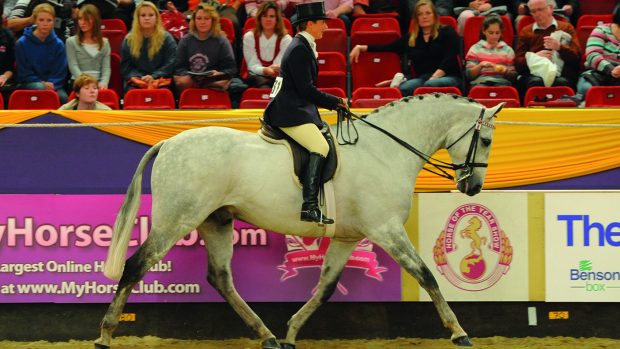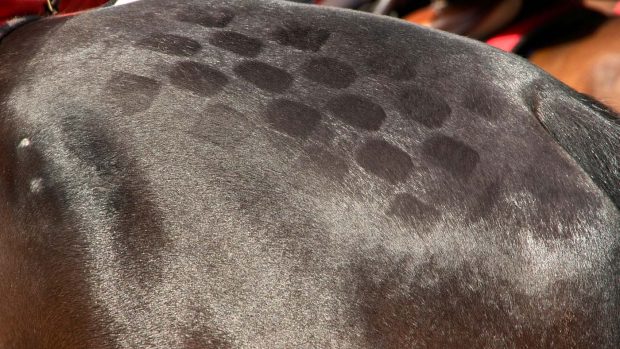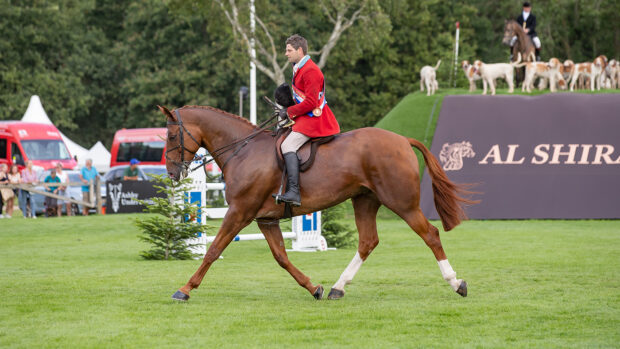The ridden hunter classes are some of the most competitive within showing. With the show season fast approaching, H&H looks at how you can make an instant impact, create the best possible picture and which definite no-nos you should avoid when showing your show hunter.
What is a show hunter?
Sport Horse Breeding (GB)’s definition of a ridden (or in-hand) hunter is “a mare or gelding capable or likely to be capable of carrying its designated weight regularly for a full day’s hunting. It should have substance, quality and a calm, bold temperament. It should have the conformation to produce high performance.”
Hunter weight divisions
Show hunters are divided into three weight sections; lightweight, middleweight and heavyweight.
- A lightweight should be able to carry up to 12st 7lb, stand around 16-16.2hh and have about eight and a half inches of bone under the knee.
- A middleweight hunter stands around 16.3hh, can carry between 12st 7lb and 14st and has around nine inches of bone.
- A heavyweight stands around 17hh, has nine to nine and a half inches of bone and is capable of carrying more than 14st.
In addition to the three weight divisions, hunters can contest small hunter classes (horses under 15.2hh), ladies’ hunter (to be ridden side-saddle) and working hunter classes, which include a jumping section.
Correct presentation for show hunters
Show hunters should be shown trimmed with mane plaited.
Judge and producer Simon Reynolds says: “You can’t have 20 plaits the size of frozen peas — it looks ridiculous. They should have nice chunky plaits neatly sewn in. If your horse is lacking a bit of top line, you can enhance the overall look by setting the plaits up in a hood, giving the illusion of more shape. If your horse is a bit too cresty, keep them low set in the neck.”
Quarter marks
“If you can’t do them properly, leave them off,” advises Simon. “Quarter marks can be an effective way of masking if a young horse is weak in their quarters, but they must be done correctly. Certain quarter marks are used for different types of show horses and hunters should have a plainer pattern of three vertical stripes with sharks teeth.”
Tails
“A hunter’s tail should be properly pulled, and never razored,” says Simon’s wife and fellow producer Natalie. “They should be cut about six inches below the point of the hock, but you need to bear in mind how your horse carries its tail as to where you cut it. A long tail looks awful, spoils the picture, elongates the horse and can alert the judge that a competitor is trying to cover up poor hocks or blemishes.”
Tack
No tack may be worn which in any way conceals an animal’s conformation. No hind boots or bandages of any description are allowed in the collecting ring, warm up or in the actual class in working hunter or ridden sports horse classes. No rugs, clothing or item of tack that reveals the identity of a horse or owner may be worn in the show ring.
“In my time as a judge I’ve ridden on some pretty awful saddles,” says Simon. “First impressions are so important. Although I’d never put a good horse down the line because of a bad saddle, I do like to feel safe, secure and comfortable.”
Correct way of going for show hunters
Show hunters should possess qualities that are recognised in the hunting field. These include good manners, ground-covering movement and, if competing in working hunter classes, a bold jumping style.
Hunters should have a straight, ground-covering movement with little knee action.
“A hunter should be light in the hand with a good, comfortable stride,” says the late hunter rider and judge Robert Oliver. “Even if your horse falls into the heavyweight section of the hunters, it still needs to move well, have great courage, sagacity and power with all the ability to cover the ground. The gallop is a true test of a good hunter being able to cover the ground, but must not take too strong a hold when asked to come back to hand. Afterwards the horse must walk quietly back into line.”
Common mistakes
“Firstly make sure your horse is in the right weight category,” says Simon. “Ask a professional for advice if you’re unsure.”
A horse being too fat is another error Simon notes. “A hunter should be fit enough to do the job. Too many are overloaded with weight and wouldn’t be capable of trotting to the meet, let alone doing half a day’s hunting.”
The SHB (GB) rule book confirms that “the society discourages the showing of over fat horses and judges will take this into consideration when making their awards.”
Riders should…
- Find a space in the ring. In the gallop get a good space so the judge can watch you, build it up off the corner and let the horse lengthen and lower so it looks smooth and natural.
- Smile — it’s meant to be fun!
Riders shouldn’t…
- Be rude to other competitors, judges and stewards.
- Overtake in front of the judge. If you need to overtake, do so courteously and with discretion as to not upset another horse.
- Never overdo it with equine make-up on a hunter, especially on a grey; it does not look natural.
- Don’t present your horse in the ring if it’s being naughty in the collecting ring. “If it’s not going correctly for you, don’t expect a judge to ride it,” says Simon. “We are not crash test dummies. There’s always another day.”
Absolute no-nos in show hunter classes
- Short jackets and loud check patterns
- Plaited browbands
- Tan coloured tack
- Ill-fitting saddles
- Wrong weighted bridles that don’t complement the horses
Where to compete
All major shows will feature classes for hunters, culminating in an overall championship. At smaller shows, the different weights may be put together.
The biggest accolades a hunter can win are the Royal International (RIHS) hunter championship, or the hunter of the year final held at Horse of the Year Show (HOYS) in October. The novice hunter class at Royal Windsor is also highly competitive and prestigious.
You might also be interested in:

20 signs you’re an incurable showing addict

Subscribe to Horse & Hound magazine today – and enjoy unlimited website access all year round
Horse & Hound magazine, out every Thursday, is packed with all the latest news and reports, as well as interviews, specials, nostalgia, vet and training advice. Find how you can enjoy the magazine delivered to your door every week, plus options to upgrade your subscription to access our online service that brings you breaking news and reports as well as other benefits.





